SRI LANKA COUNTRY OVERVIEW
TEMPLE OF THE SACRED TOOTH RELIC/SRI DALADA MALIGAWA, KANDY
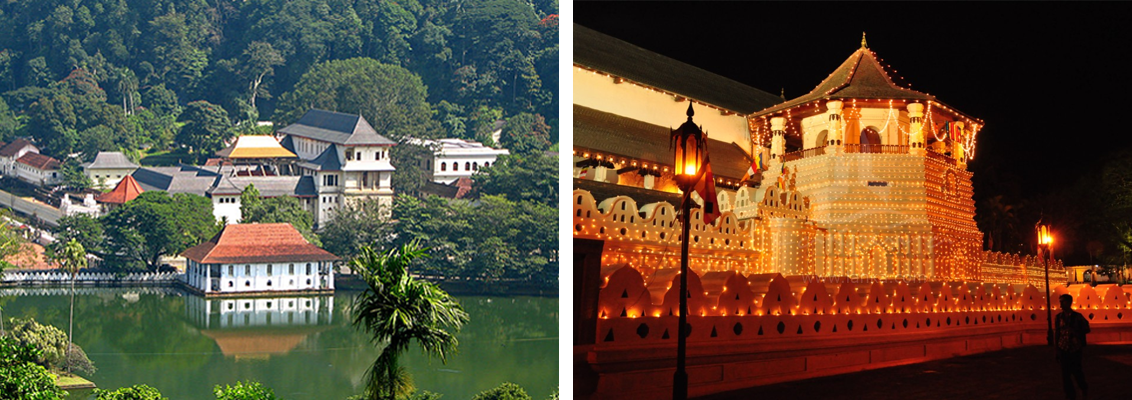
The Temple of the Sacred Tooth Relic/Sri Dalada Maligawa is a Buddhist temple in the city of Kandy, Sri Lanka. It is located in the royal palace complex of the former Kingdom of Kandy, which houses the relic of the tooth of the Buddha. Since ancient times, the relic has played an important role in local politics because it is believed that whoever holds the relic holds the governance of the country. Kandy was the last capital of the Sri Lankan kings and is a World Heritage Site mainly due to the temple.
ROYAL BOTANICAL GARDEN, PERADENIYA
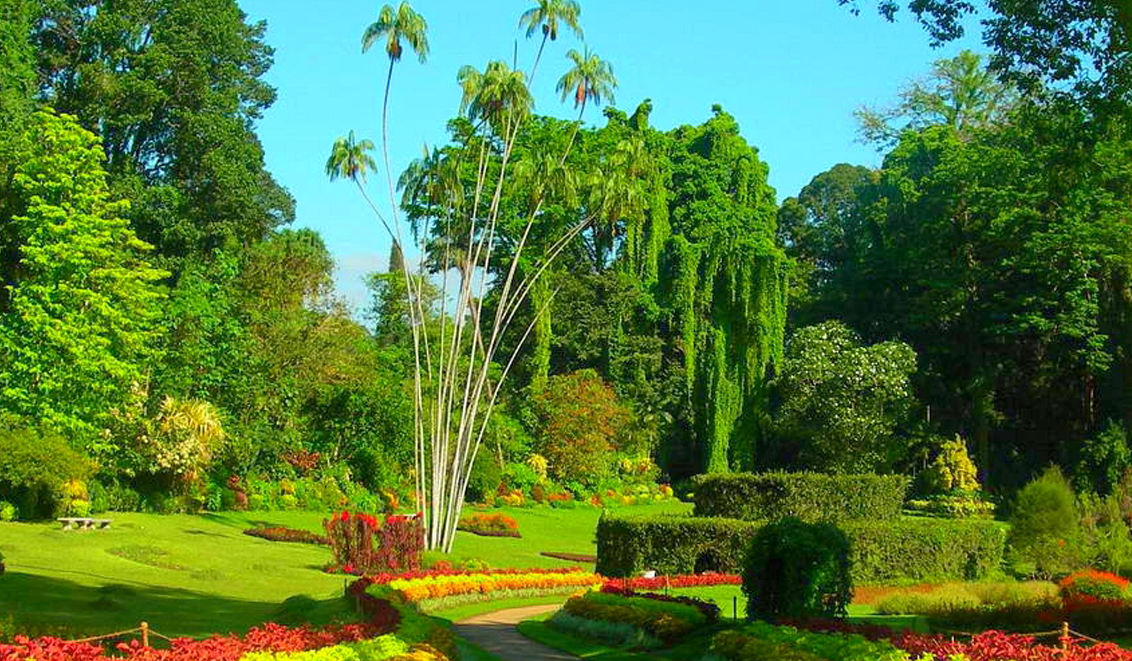
Royal Botanical Garden, Peradeniya is situated about 5.5 km to the west from the city of Kandy in the Central Province of Sri Lanka and attracts 2 million visitors annually. It is renowned for its collection of a variety of orchids. It includes more than 4000 species of plants, including of orchids, spices, medicinal plants and palm trees. Attached to it is the National Herbarium of Sri Lanka.
The total area of the botanical garden is 147 acres (0.59 km2), at 460 meters above sea level, and with a 200-day annual rainfall. It is managed by the Division of National Botanic Gardens of the Department of Agriculture.
PINNAWALA ELEPHANT ORPHANAGE

Pinnawala Elephant Orphanage is an orphanage, nursery and captive breeding ground for wild Asian elephants located at Pinnawala village, 13 km (8.1 mi) northeast of Kegalle town in Sabaragamuwa Province of Sri Lanka. Pinnawala is notable for having the largest herd of captive elephants in the world.
The orphanage was originally founded in order to afford care and protection to many of the orphaned unweaned wild elephants found wandering in and near the forests of Sri Lanka. It was established in 1975 by the Sri Lanka Department of Wildlife Conservation (DWC).
SIGIRIYA ROCK FORTRESS
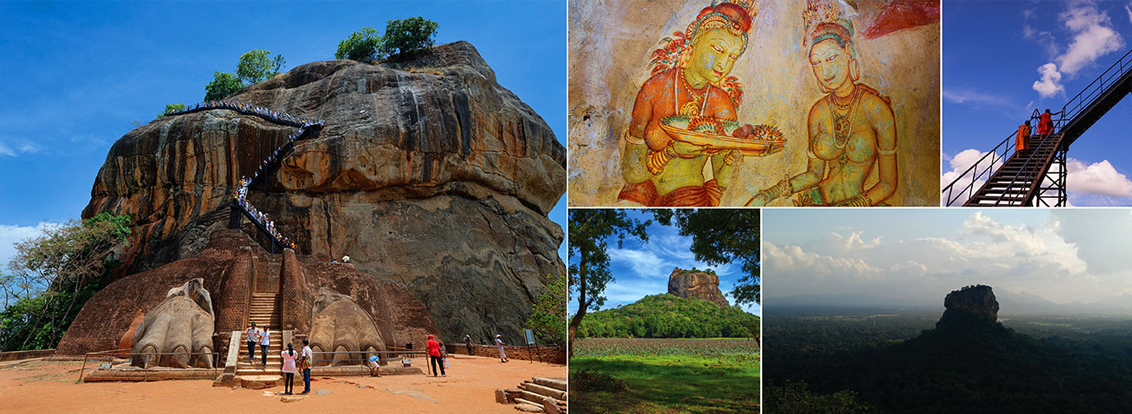
The spectacular Rock Fortress of Sigiriya, 19 kilometers North East of Dambulla is one of Sri Lanka's major attractions. The Rock was the Fortress of the "King Kasyapa" who murdered his father and stole the throne from his elder brother who was the rightful heir to the throne. Kasyapa built his fortress in this 182 meter high rock to protect himself from his enemies.
Sigiriya may have been inhabited through prehistoric times. It was used as a rock-shelter mountain monastery from about the 3rd century BC, with caves prepared and donated by devotees to the Buddhist Sangha. The garden and palace were built by Kasyapa 477 - 495 AD. Following Kasyapa's death it was again a monastery complex up to about the 14th century, after which it was abandoned. The ruins were discovered in 1907 by British Explorer John Still.
Today Sigiriya is famous for its 'Mirror Wall', which consists of poems and paragraphs carved by visitors to the rock many years ago and for its magnificent frescoes of shapely be-jewelled maidens, vibrant colours and the water garden similar to the Ajantha frescoes of India. Sigiriya is in fact, the best-preserved city center in Asia from the first millennium and has been named as a UNESCO world heritage site and 08th Wonder of the World.
DAMBULLA CAVE TEMPLE

Dambulla cave temple also known as the Golden Temple of Dambulla is a World Heritage Site (1991) in Sri Lanka, situated in the central part of the country. This site is situated 148 kilometers (92 mi) east of Colombo and 72 kilometers (45 mi) north of Kandy. It is the largest and best-preserved cave temple complex in Sri Lanka. The rock towers 160 m over the surrounding plains. There are more than 80 documented caves in the surrounding area. Major attractions are spread over five caves, which contain statues and paintings. These paintings and statues are related to Gautama Buddha and his life. There are a total of 153 Buddha statues, three statues of Sri Lankan kings and four statues of gods and goddesses. The latter include Vishnu and the Ganesha. The murals cover an area of 2,100 square meters (23,000 sq ft). Depictions on the walls of the caves include the temptation by the demon Mara, and Buddha's first sermon.
The history of Golden Temple goes back to the first century B.C., commenced by the King Vattagamini Abhaya and thereafter kings, Maha Parakramabahu, Nissankamalala, Keerthi Sri Rajasinghe and five cave temples, particularly named, Devaraja Viharaya, Maharaja Viharaya, Maha Alut Viharaya. Paschima Viharaya and Devena Alut Viaharaya respectively.
Within these five caves is housed a collection of 157 valuable images of the Buddha and Bodhisatta etc. Inside the caves the rock surfaces, ceiling and side walls are covered with paintings executed with indigenous traditional colour schemes to an extent of about 22,000 square feet. The inscription in the premises records that the temple had been named "Rangiri Dambulla" when the images were painted in gold by King Nissankamalala of the Polonnaruwa regime. The temple with its historical, archeological and artistic significances had in the year 1991, been declared one of the world heritages sites by the UNESCO.
POLONNARUWA

The 02nd ancient capital of Sri Lanka. The city, now a UNESCO World Heritage Site. the Capital of Sri Lanka from the 11th to 13th century, a well-planned medieval city defended by enclosing walls (around 5 km. which still remain), graced by palaces, shrines, monasteries, pavilions, parks, ponds and irrigation lakes. Polonnaruwa is strewn with ruins in a resplendent state of preservation. Of these the 'Vatadage' and the 'Thuparama Image House' are the most spectacular. The 'Gal Vihara' which consists of statues of the recumbent, standing and seated Buddha have been cut from a single granite wall and rank among the true masterpieces of Sri Lankan Art.
HIKKADUWA
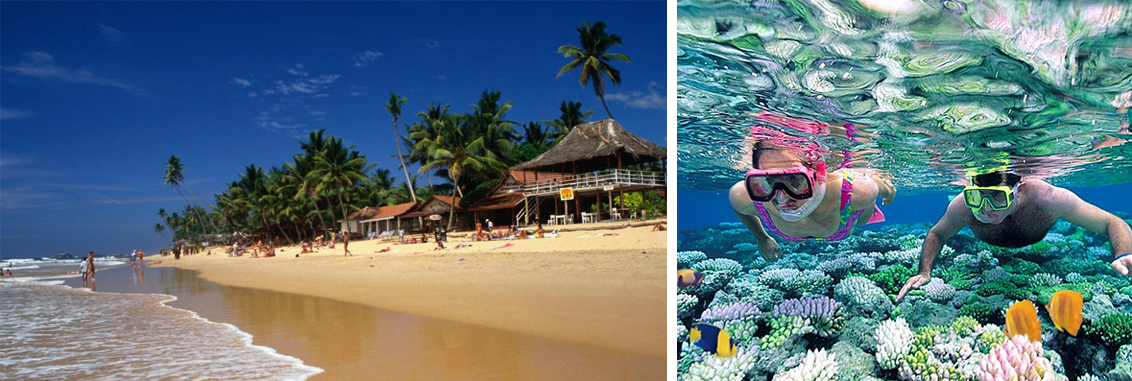
A one and half hour drive along the Turquoise Indian Ocean brings you to Hikkaduwa and another series of exciting dives (only for PADI, CMAS, SSI, FFESSM certified guests).
- The conch-One of the first oil tankers of the Shell Company which sank in 1903 after hitting the Akarta rock. Diving depth: 14.22 m. Travel time by boat: 20 minutes.
- Wrecks of Ship Earl of Shaftsbury - This four mastered British ship wreck sank back in 1893 and are home to stingrays, schools of snappers, barracudas, lion fish and blow fish. Diving depth: 15 m. Travel time by boat: 15 minutes.
- Other Diving Sites of Hikkaduwa Include,
- Seenigamagala Rock - A site covered with beautiful and uniquely formed corals and a habitat of barracudas, moray eels and rays. Diving depth: 12-22 m. travel time by boat: 10 minutes
- Kiralagala - A beautiful rock complex filled with exotic fish. The precipitous rock wall is covered with hard and soft corals creating a marine town filled with domino damsels, angel fish, basslets, butterfly fish and the deeper oceans filled with Trevally, fusiliers and triggerfish. Diving depth: 40 m. Travel time by boat: 25 minutes
- Diyamba Gala or Deep rock - A multilevel rock complex consists of underground caves. Diving depth-22 m. Travel time by boat: 20 minutes.
- Off coral gardens - A coral formation with coral caves and valleys, home to moray eels, puffer fish and blow fish. Diving depth: 13 m. Travel time by boat: 10 minutes.
- Black coral point -A deep dive site covered with black corals and abundant of macro marine creatures. Diving depth: 30 m. Travel time by boat: 10 minutes.
- Goda gala - The multi-level rock complex spreading over a large area is home to variety of sea creatures including Moray Eels, Hawk fish, small Crabson Acropora Coral, Antheas and other reef fish.
- Sunil Gala - Another multi-level rock formation with varying depths from 4-18 meters. A challenging dive due to the relentless surge caused by its proximity to the shore, the site offers reef fish like Angelfish, Boxfish & Surgeonfish. Diving depth: 18 m. Travel time by boat: 20 minuets.
LAKE GREGORY

Lake Gregory is a picturesque, man-made Lake nestled at the bottom of small hills, bordering the town of Nuwara Eliya in Sri Lanka's mountainous, tea-growing region. A visit or tour of Nuwara Eliya would not be complete without a visit to this scenic lake, with perhaps a boat ride or a walk along its shores. Originally a swamp and bog that was described by early residents as an "eye sore", Lake Gregory was created by diverting the waters of the Thalagala stream which flows from the nearby Piduruthalagala mountain range.
HORTON PLAINS NATIONAL PARK

Horton Plains National Park is a protected area in the central highlands of Sri Lanka and is covered by montane grassland and cloud forest. This plateau at an altitude of 2,100-2,300 metres (6,900-7,500 ft) is rich in biodiversity and many species found here are endemic to the region.
The Horton Plains are the headwaters of three major Sri Lankan rivers, the Mahaweli, Kelani, and Walawe. In Sinhala the plains are known as Maha Eliya Plains. Stone tools dating back to Balangoda culture have been found here. The plains' vegetation is grasslands interspersed with montane forest, and includes many endemic woody plants. Large herds of Sri Lankan sambar deer feature as typical mammals, and the park is also an Important Bird Area with many species not only endemic to Sri Lanka but restricted to the Horton Plains.;
LAXAPANA FALLS
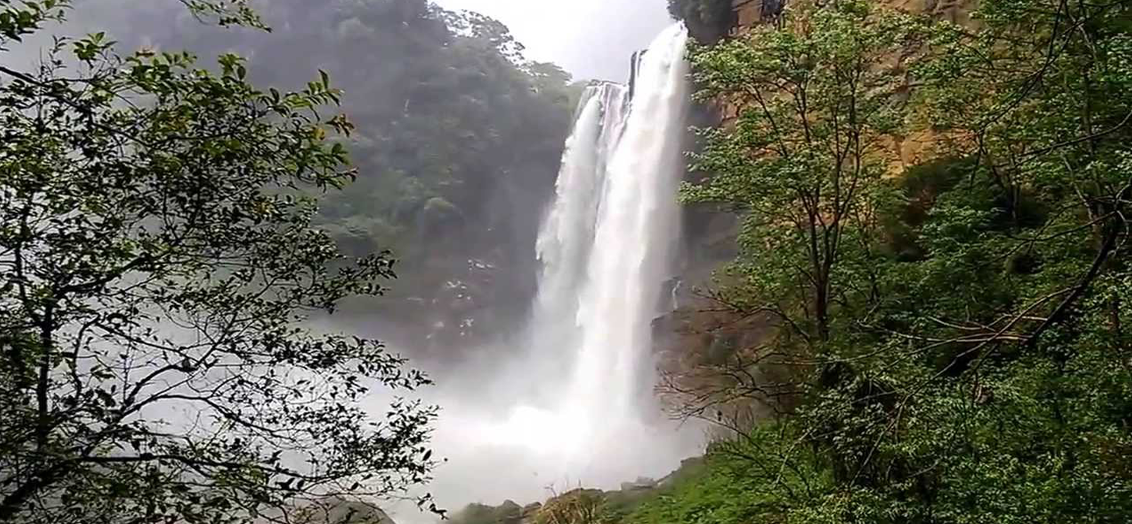
One of Sri Lanka's most famous waterfalls, and perhaps the one that has proven the most useful in terms of generating power to the country. The Laxapana Falls falls are 129m high and rise from the Laxapana estate and plunges into the Maskeliya Oya via Maoussakelle. The waters of this mountainous river are fast moving, rushing over huge boulders and rocks, gurgling across a multitude of small streams around the mountains before emerging as an awe-inspiring waterfall, especially during the monsoon season when the rivers are swollen and full.
YALA NATIONAL PARK

The most visited and second largest national park in Sri Lanka. The park consists of five blocks, two of which are now open to the public, and also adjoining parks. The blocks have individual names such as, Ruhuna National Park (block 1) and Kumana National Park or 'Yala East' for the adjoining area. It is situated in the southeast region of the country, and lies in Southern Province and Uva Province. The park covers 979 square kilometres (378 sq mi) and is located about 300 kilometres (190 mi) from Colombo. Yala was designated as a wildlife sanctuary in 1900, and, along with Wilpattu was one of the first two national parks in Sri Lanka, having been designated in 1938. The park is best known for its variety of wild animals. It is important for the conservation of Sri Lankan elephants, Sri Lankan leopards and aquatic birds.
There are six national parks and three wildlife sanctuaries in the vicinity of Yala. Among the largest is Lunugamvehera National Park. The park is situated in the dry semi-arid climatic region and rain is received mainly during the northeast monsoon. Yala hosts a variety of ecosystems ranging from moist monsoon forests to freshwater and marine wetlands. It is one of the 70 Important Bird Areas (IBAs) in Sri Lanka. Yala harbours 215 bird species including six endemic species of Sri Lanka. The number of mammals that has been recorded from the park is 44, and it has one of the highest leopard densities in the world.
The area around Yala has hosted several ancient civilisations. Two important pilgrim sites, Sithulpahuwa and Magul Vihara, are situated within the park. The 2004 Indian Ocean tsunami caused severe damage on the Yala National Park and 250 people died in its vicinity. The number of visitors has been on the rise since 2009 after the security situation in the park improved.
ANURADHAPURA
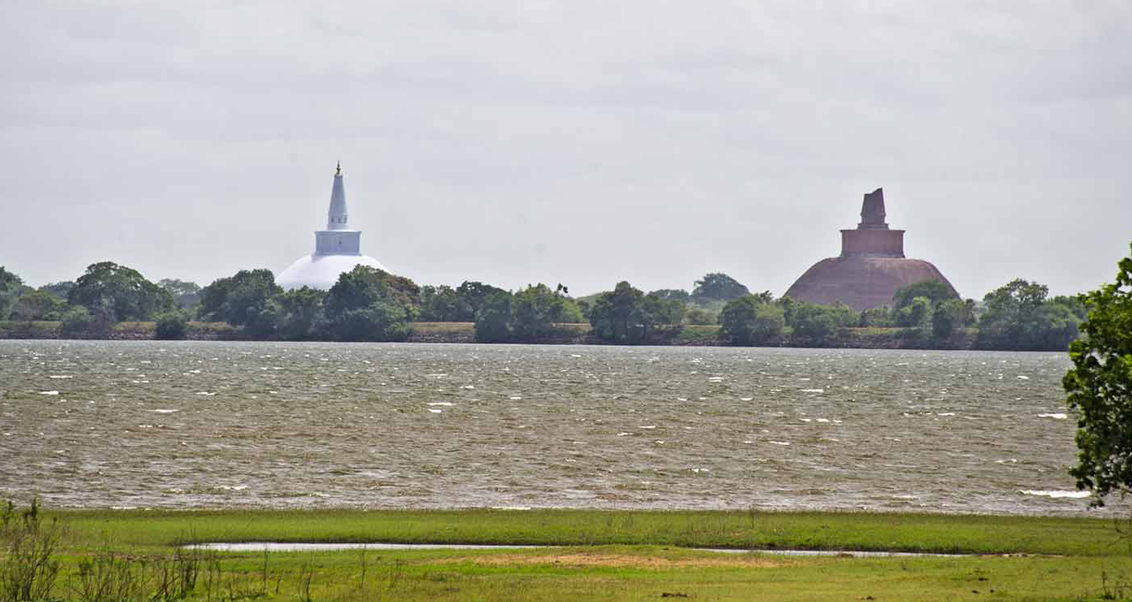
The city, now a UNESCO World Heritage Site, was the center of Theravada Buddhism for many centuries. The city lies 205 km north of the current capital Colombo in Sri Lanka's North Central Province, on the banks of the historic Malvathu Oya. It is one of the oldest continuously inhabited cities in the world and one of the eight World Heritage Sites of Sri Lanka. It is believed that from the 4th century BC, it was the capital of the Sinhalese until the beginning of the 11th century AD. During this period it remained one of the most stable and durable centers of political power and urban life in South Asia. The ancient city, considered sacred to the Buddhist world, is today surrounded by monasteries covering an area of over sixteen square miles (40 km2).
GALLE FORT
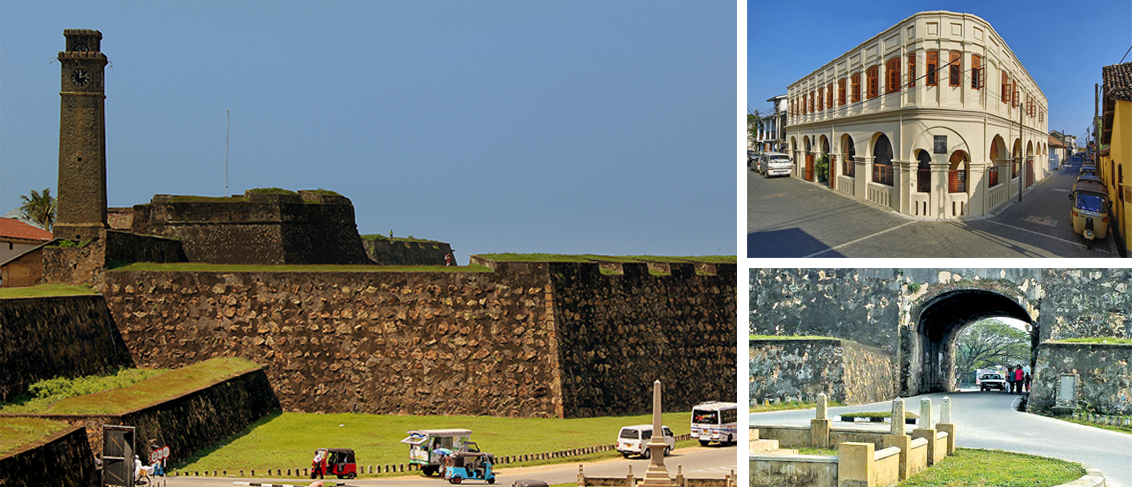
Galle Fort, in the Bay of Galle on the southwest coast of Sri Lanka, was built first in 1588 by the Portuguese, then extensively fortified by the Dutch during the 17th century from 1649 onwards. It is a historical, archaeological and architectural heritage monument, which even after more than 423 years maintains a polished appearance, due to extensive reconstruction work done by Archaeological Department of Sri Lanka.
The fort has a colourful history, and today has a multi-ethnic and multi-religious population. The Sri Lankan government and many Dutch people who still own some of the properties inside the fort are looking at making this one of the modern wonders of the world. The heritage value of the fort has been recognized by the UNESCO and the site has been inscribed as a cultural heritage UNESCO World Heritage Site under criteria iv, for its unique exposition of "an urban ensemble which illustrates the interaction of European architecture and South Asian traditions from the 16th to the 19th centuries."
ARUGAM BAY
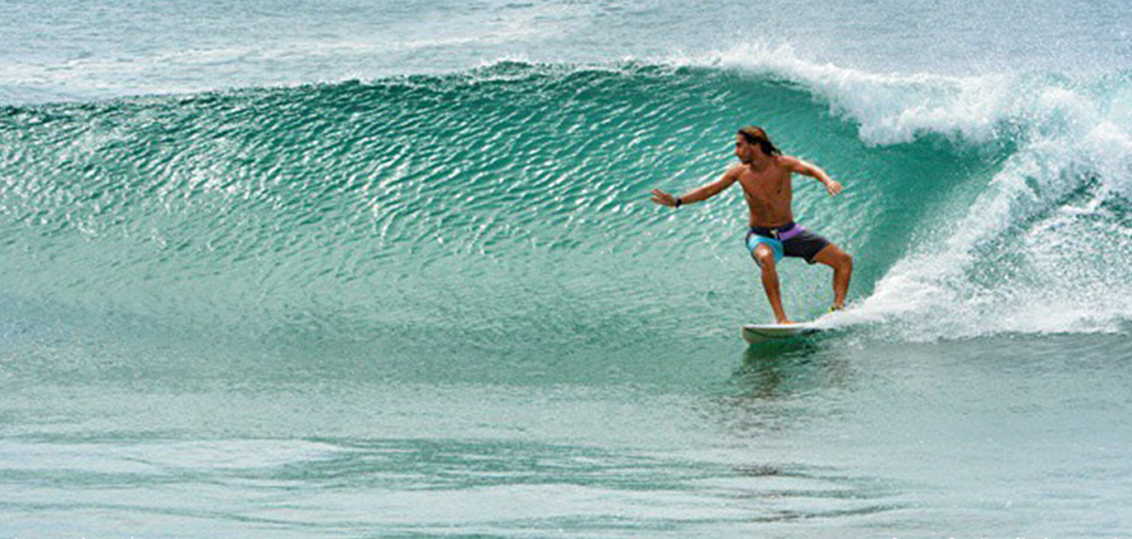
Arugam Bay is a bay situated on the Indian Ocean in the dry zone of Sri Lanka's southeast coast. The bay is located 320 kilometres (200 mi) due east of Colombo, and approximately 4 kilometres (2.5 mi) south of the market town of Pottuvil.
The Arugam Bay area is home to a number of quality surf breaks, the most popular of which being 'Main Point' located towards the south of the bay. This is a right hand point break, with a rock/reef bottom, and has a number of sections with occasional barrels. Other breaks in the area include Whiskey Point and Pottuvil Point to the north, and Elephant Rock, Peanut Farm and Okanda to the south. These breaks have attracted a steady stream of international tourists for several decades. Arugam Bay has a good local surf scene and is home to some of Sri Lanka's most talented surfers and in recent years surfers from Arugam Bay have dominated national competitions. In mid-2010 the Association of Surfing Professionals hosted its first international surf contest in the Bay. The winner of such was Australian Julian Wilson. ASP repeated their contest tour in 2011 added a women's competition to the men's long board championship at Arugam Bay.

